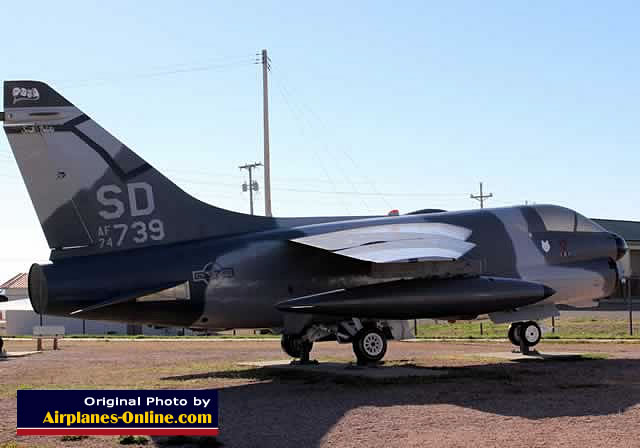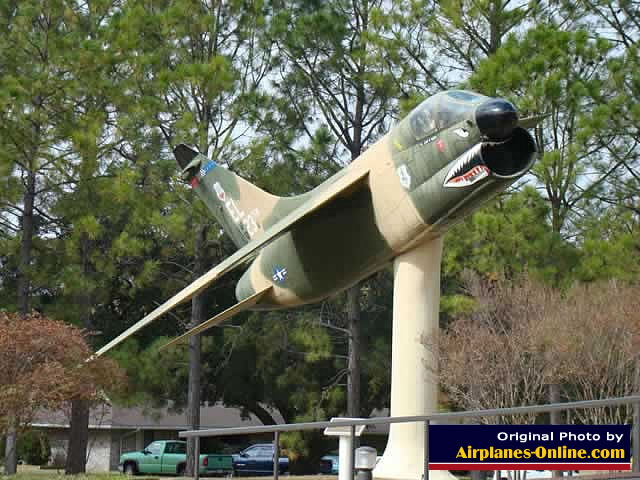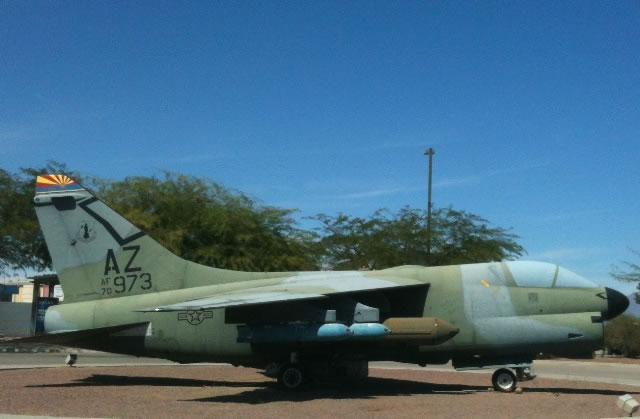The A-7 Corsair II
History of the A-7 Corsair II Airplane
The A-7 Corsair II was developed in response to a Navy requirement for a single-place, fair-weather subsonic attack plane capable of carrying a much heavier weapons load than the Douglas A-4 Skyhawk.
|
The Ling-Temco-Vought (LTV) A-7 Corsair II is a carrier-capable subsonic light-attack aircraft. The A-7 airframe design was based on the successful supersonic Vought F-8 Crusader. The A-7 offered a wide range of leading-edge avionics compared to contemporary aircraft.
An obvious difference between the F-8 and A7 is the overall size, with the A-7 being considerably shorter and stubbier.
Like the F-8, the configuration of the A-7 is characterized by a high wing, low horizontal tail, chin inlet, and short landing-gear legs that retract into the fuselage.
Original power plant of the A-7 was a nonafterburning version of the Pratt & Whitney TF30 turbofan. This is the same engine that, equipped with an afterburner, powers both the F-111 and the F-14. Beginning with the A-7D, however, the more powerful Allison TF41-A-1 turbofan, an American version of the British Rolls-Royce Spey engine, was installed.
The Corsair II initially entered service with the United States Navy during the Vietnam War. The plane was later adopted by the United States Air Force, including the Air National Guard.
The A-7 had a fast and smooth development. The YA-7A made its first flight in September of 1965, entered Navy squadron service late in 1966. The first Navy A-7 squadrons reached operational status in February of 1967, and began combat operations over Vietnam in December of that year.
The A-7 is unofficially called by U.S. Air Force crews the "SLUF" ... Short Little Ugly Fella, or actually some more frequently used variation of "fella" !
Production and Deployment of the A-7
A total of 1,569 A-7 aircraft would ultimately be built, including 459 to the U.S. Air Force. It was also utilized in many foreign countries.
|
In 1973 the USAF began assigning A-7Ds to the Air National Guard (ANG), and by 1987 the planes were being flown by ANG units in 10 states and Puerto Rico. The A-7D was delivered in significant numbers to the Air National Guard, many new from the factory. The ANG continued to improve the A-7D throughout the 1970s.
Retirement of the last two Navy A-7 aircraft fleet operational squadrons (VA-46 and VA-72) was in May of 1991.
A total of 535 A-7Es were built, the last plane being delivered in 1983. At its peak in the mid-1980s, 22 Navy attack squadrons were using the A-7E. The last of the A-7A squadrons were disestablished and the last of the A-7Bs were transferred to reserve squadrons by 1977.
A-7 Corsair II General Specifications
Crew: 1
Length: 46 ft 1.5 in
Wingspan: 38 ft 9 in
Height: 16 ft 0.75 in
Wing area: 375 ft²
Airfoil: NACA 65A007 root and tip
Empty weight: 19,490 lb
Max. takeoff weight: 42,000 lb
Powerplant: 1 × Allison TF41-A-2 turbofan, 14,500 lbf
Maximum speed: 600 knots
Combat radius: 621 nmi
Service ceiling: 42,000 ft.
Surviving A-7 Corsairs
U.S. Navy A-7 Corsairs began being phased out of the fleet during the mid-1980s with the arrival of the McDonnell Douglas F/A-18 Hornet. The last Navy A-7s were retired by the last fleet operational squadrons (VA-46 and VA-72) in May 1991 shortly after their return from Operation Desert Storm. Some of these surplus aircraft were passed to Greece, Thailand and Portugal.
However by the end of 1998, with the exception of some airframes used as static displays, all U.S. A-7s were disposed of by the Davis-Monthan AFB's AMARG facility in Tucson, Arizona.
A number of A-7 models are on display in the United States, as follows:
- A-7A - 5 aircraft
- A-7B - 1 aircraft
- TA-7C - 7 aircraft
- A-7D - 24 aircraft
- A-7E - 15 aircraft
Photos of Surviving A-7 Corsairs
A-7D Corsair
II S/N 72-0175 on display at the Charles B. Hall Airpark at the Air Depot Boulevard gate to Tinker Air Force Base, Oklahoma City, Oklahoma |
 |
U.S. Air Force A-7D Corsair, S/N 74739, Tail Code SD, outside Ellsworth AFB, South Dakota |
 |
LTV Corsair II Bureau Number 154407 in Albuquerque |
 |
A-7D Corsair II of the 23rd Tactical Fighter Wing on static display at the closed England AFB in Alexandria, Louisiana |
 |
YA-7F Corsair II S/N 70-1039 on display at the Hill Aerospace Museum near Salt Lake City, UT |
 |
A-7D Corsair II S/N 70973, Tail Code AZ, on display at the Pima Air & Space Museum in Tucson, Arizona |
 |
A-7 Corsair II 401 in Tillamook, Oregon |
 |
Photos of Surviving A-7s by Our Friends and Supporters
A-7D Corsair, S/N 70001, on display at Buckley Air Force Base, Aurora, Colorado (photo by Michael Hoschouer) |
 |


